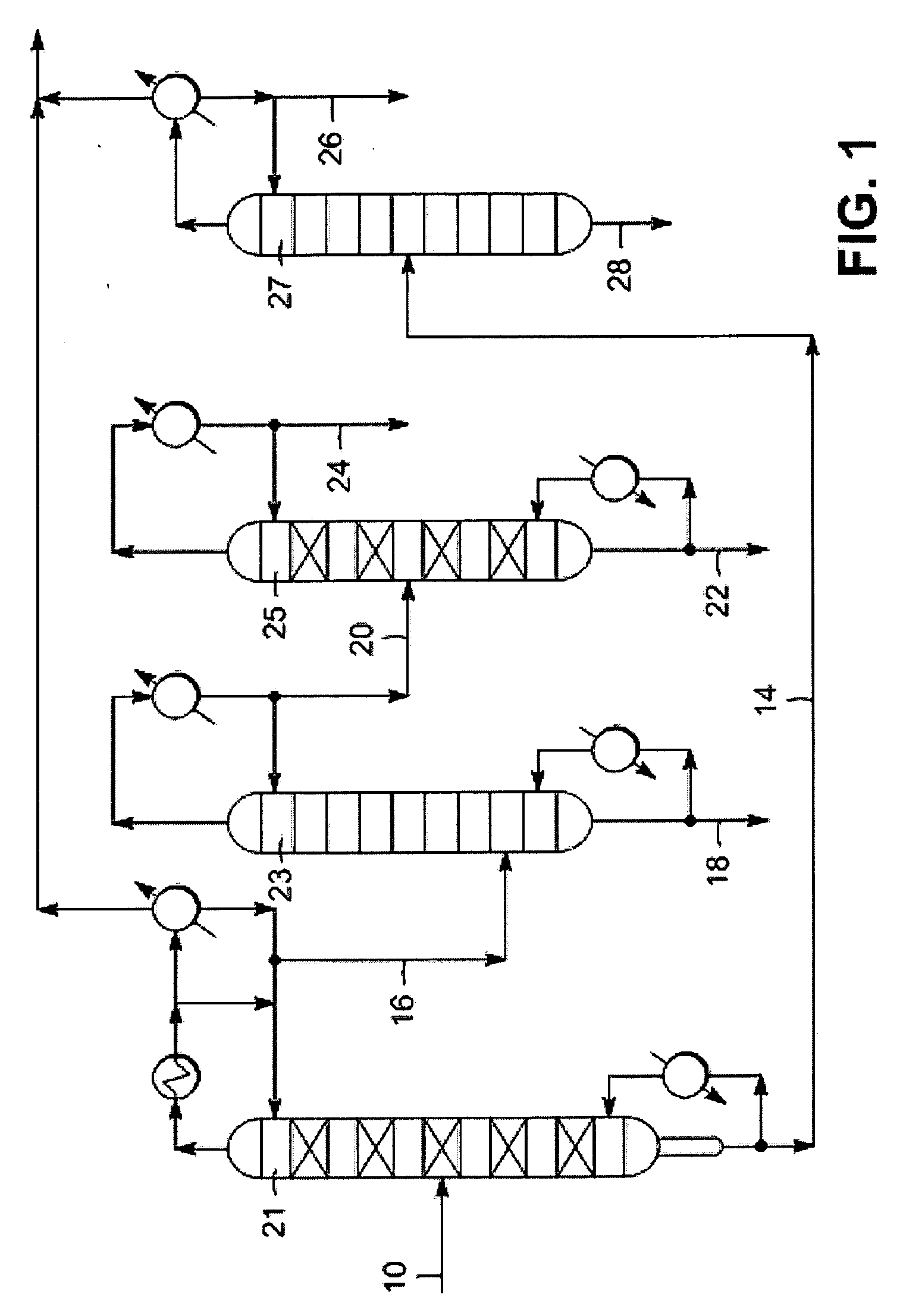Selective hydrogenation of unsaturated aliphatic hydrocarbons in predominantly aromatic streams
a technology of unsaturated aliphatic hydrocarbons and aromatic streams, which is applied in the direction of hydrocarbon purification/separation, chemical instruments and processes, organic chemistry, etc., can solve the problems of adversely affecting the performance of nitrogen adsorption materials, and achieve the effect of shortening the effective life of adsorbents and shortening the effective li
- Summary
- Abstract
- Description
- Claims
- Application Information
AI Technical Summary
Benefits of technology
Problems solved by technology
Method used
Image
Examples
example 1
Benzene Recovered from an EB Dehydrogenation Effluent Stream
[0041]A sample of a predominantly benzene stream recovered from an EB dehydrogenation effluent stream was analyzed for impurity levels using a standard analysis based on gas chromatography (GC). The analysis showed that this stream contained 1146 ppm by weight of diolefins in the C4-C6 carbon range, and in particular this represented the combined amount of the diolefins 1,3-butadiene, 1,2-butadiene, 1,4-pentadiene, 2-methyl-1,3-butadiene, 1-trans-3-pentadiene, 3-methyl-1,2-butadiene, cyclopentadiene, 1-cis-3-pentadiene, 1,4-hexadiene, 2,3-dimethyl-1,3-butadiene, trans-1,3-hexadiene, and cis-1,3-hexadiene. The stream also had 322 ppm by weight of mono-olefins in the C4-C6 carbon range and 3 ppm of acetylene. The Bromine Number of this liquid stream, determined according to ASTM D1159, was 0.29.
[0042]This liquid stream was representative of a benzene stream that would be treated for nitrogen removal using a nitrogen guard bed...
example 2
Selective Hydrogenation of Diolefins in a Model Hydrogenation Feed Stream
[0043]A model hydrogenation feed stream comprising benzene and approximating the diolefin and olefin content of a commercial benzene / toluene splitter overhead stream of the separation section of a styrene production process, as well as its nitrogen content, was prepared. The model liquid contained benzene with 1000 ppm of diolefins as either pentadiene or hexadiene, 300 ppm of mono-olefins as pentene, and 100 ppm of acetonitrile. The model hydrogenation feed stream was selectively hydrogenated by passing it over a palladium containing catalyst at 120° C. (248° F.) and 28 barg (400 psig) and at a liquid hourly space velocity (LHSV) of 25 hr−1. Hydrogen was added in at a molar ratio of 5.0, based on the total moles of diolefins (dienes) and acetonitrile in the hydrogenation feed stream. The conversion of the diolefins was 92.9%, while saturation of the benzene was negligible.
example 3
Nitrogen Removal from a Commercial Benzene / Toluene Splitter Overhead Stream
[0044]The predominantly benzene stream recovered from an EB dehydrogenation effluent stream (namely a commercial benzene / toluene splitter overhead stream, obtained from the separation section of a styrene production process), as described in Example 1, was treated with a zeolitic guard bed to remove nitrogen. Table 1 below shows the analysis of this stream, both before and after this treatment.
TABLE 1Nitrogen GuardNitrogen GuardStreamBed InletBed OutletAromatics Distribution (wt %)Benzene99.47299.473Toluene0.3090.313Styrene00C8 alkylbenzene00.004C9 alkylbenzene00.034C10 alkylbenzene0.0030.014C11+ alkylbenzene0.0010.036Nonaromatics0.2150.112Basic Nitrogen (wt %)Nitrogen (wt ppm)3.21Sulfur (wt ppm)Bromine Number (g Br / 100 g)0.3080.167Mono-olefin, ppm322Di-Olefin, ppm1146Acetylene, ppm3
[0045]The analytical results above show that although the nitrogen content was reduced across the guard bed, there was still 1 p...
PUM
| Property | Measurement | Unit |
|---|---|---|
| Bromine Number | aaaaa | aaaaa |
| temperature | aaaaa | aaaaa |
| Bromine Number | aaaaa | aaaaa |
Abstract
Description
Claims
Application Information
 Login to View More
Login to View More - R&D
- Intellectual Property
- Life Sciences
- Materials
- Tech Scout
- Unparalleled Data Quality
- Higher Quality Content
- 60% Fewer Hallucinations
Browse by: Latest US Patents, China's latest patents, Technical Efficacy Thesaurus, Application Domain, Technology Topic, Popular Technical Reports.
© 2025 PatSnap. All rights reserved.Legal|Privacy policy|Modern Slavery Act Transparency Statement|Sitemap|About US| Contact US: help@patsnap.com

